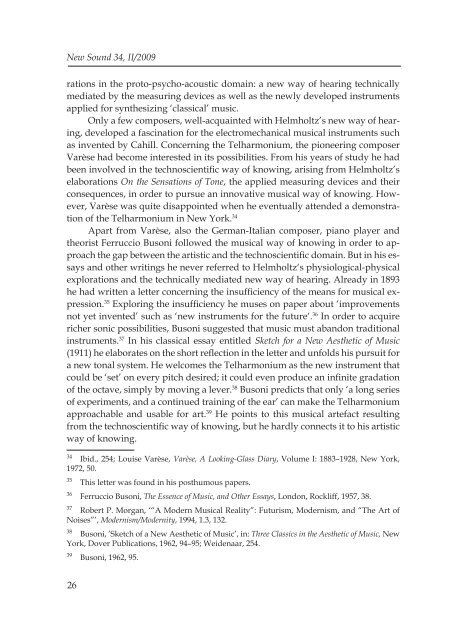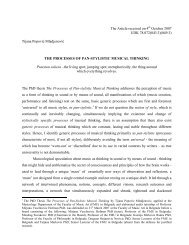John Heymans1 FROM HELMHOLTZ'S SENSATIONS ... - New Sound
John Heymans1 FROM HELMHOLTZ'S SENSATIONS ... - New Sound
John Heymans1 FROM HELMHOLTZ'S SENSATIONS ... - New Sound
You also want an ePaper? Increase the reach of your titles
YUMPU automatically turns print PDFs into web optimized ePapers that Google loves.
<strong>New</strong> <strong>Sound</strong> 34, II/2009<br />
rations in the proto-psycho-acoustic domain: a new way of hearing technically<br />
mediated by the measuring devices as well as the newly developed instruments<br />
applied for synthesizing ‘classical’ music.<br />
Only a few composers, well-acquainted with Helmholtz’s new way of hearing,<br />
developed a fascination for the electromechanical musical instruments such<br />
as invented by Cahill. Concerning the Telharmonium, the pioneering composer<br />
Varèse had become interested in its possibilities. From his years of study he had<br />
been involved in the technoscientifi c way of knowing, arising from Helmholtz’s<br />
elaborations On the Sensations of Tone, the applied measuring devices and their<br />
consequences, in order to pursue an innovative musical way of knowing. However,<br />
Varèse was quite disappointed when he eventually attended a demonstration<br />
of the Telharmonium in <strong>New</strong> York. 34<br />
Apart from Varèse, also the German-Italian composer, piano player and<br />
theorist Ferruccio Busoni followed the musical way of knowing in order to approach<br />
the gap between the artistic and the technoscientifi c domain. But in his essays<br />
and other writings he never referred to Helmholtz‘s physiological-physical<br />
explorations and the technically mediated new way of hearing. Already in 1893<br />
he had written a letter concerning the insuffi ciency of the means for musical expression.<br />
35 Exploring the insuffi ciency he muses on paper about ‘improvements<br />
not yet invented’ such as ‘new instruments for the future‘. 36 In order to acquire<br />
richer sonic possibilities, Busoni suggested that music must abandon traditional<br />
instruments. 37 In his classical essay entitled Sketch for a <strong>New</strong> Aesthetic of Music<br />
(1911) he elaborates on the short refl ection in the letter and unfolds his pursuit for<br />
a new tonal system. He welcomes the Telharmonium as the new instrument that<br />
could be ‘set’ on every pitch desired; it could even produce an infi nite gradation<br />
of the octave, simply by moving a lever. 38 Busoni predicts that only ‘a long series<br />
of experiments, and a continued training of the ear’ can make the Telharmonium<br />
approachable and usable for art. 39 He points to this musical artefact resulting<br />
from the technoscientifi c way of knowing, but he hardly connects it to his artistic<br />
way of knowing.<br />
34 Ibid., 254; Louise Varèse, Varèse, A Looking-Glass Diary, Volume I: 1883–1928, <strong>New</strong> York,<br />
1972, 50.<br />
35 This letter was found in his posthumous papers.<br />
36 Ferruccio Busoni, The Essence of Music, and Other Essays, London, Rockliff, 1957, 38.<br />
37 Robert P. Morgan, ‘“A Modern Musical Reality”: Futurism, Modernism, and “The Art of<br />
Noises”’, Modernism/Modernity, 1994, 1.3, 132.<br />
38 Busoni, ’Sketch of a <strong>New</strong> Aesthetic of Music’, in: Three Classics in the Aesthetic of Music, <strong>New</strong><br />
York, Dover Publications, 1962, 94–95; Weidenaar, 254.<br />
39 Busoni, 1962, 95.<br />
26



